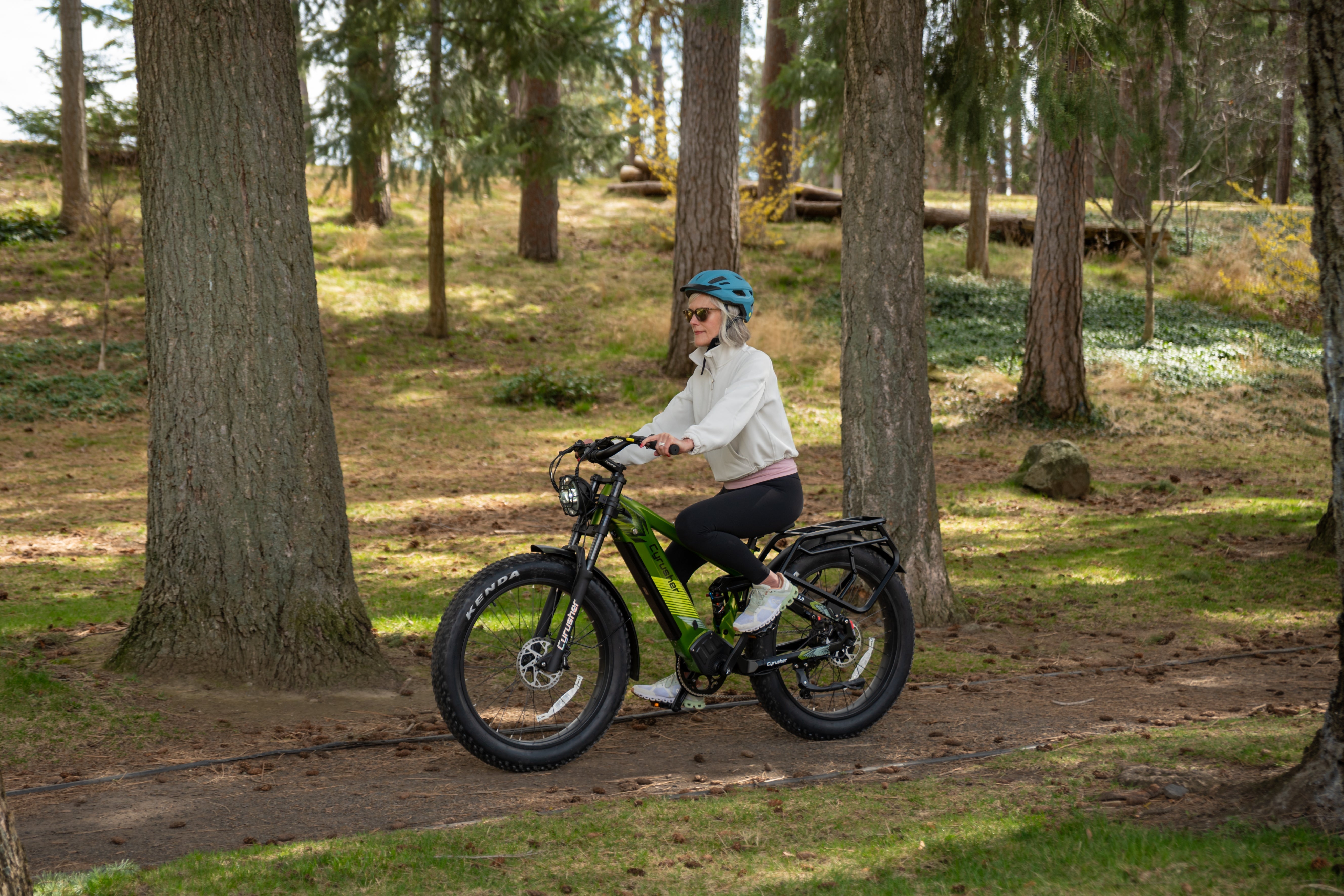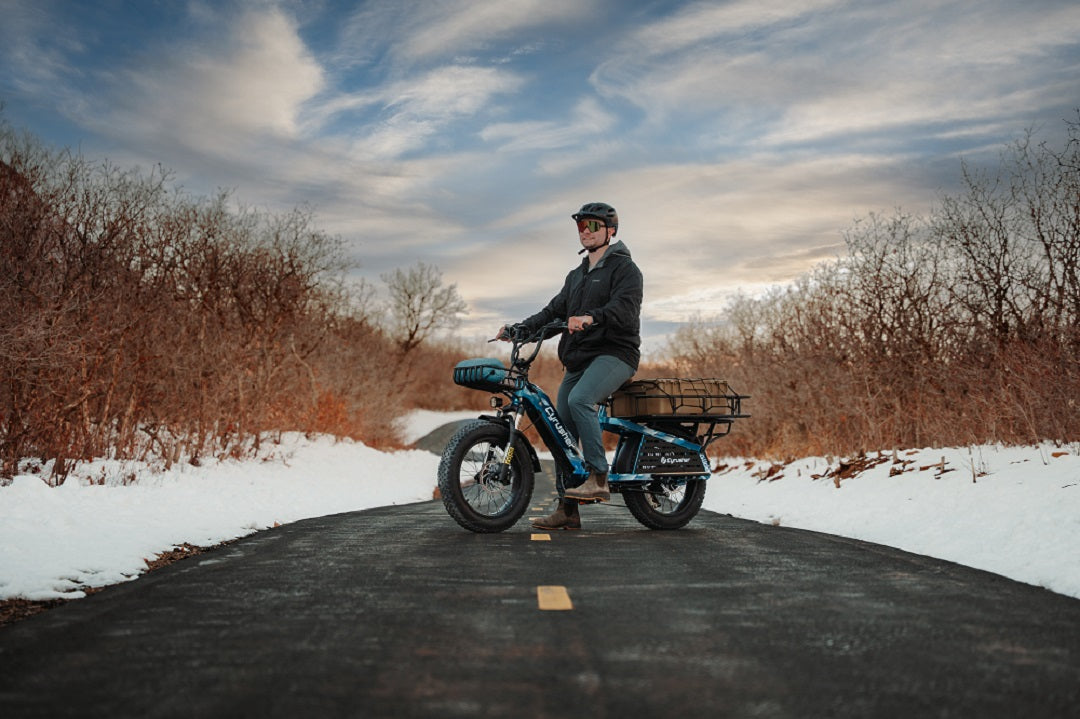E-bike safety must take into account battery safety, especially in the summer when charging in hot weather increases the risk of battery safety issues. In this article, you will find safety tips regarding summer e-bike charging and battery maintenance to help you enjoy your summer rides more safely.
Dangerous summer riding behaviour
Riding in the hot summer for long periods of time
Although e-bikes are a convenient means of transportation that can help you stay cool during commutes, there are still risks associated with exposure to direct sunlight for long periods. One of the concerns is the rider's well-being, as prolonged exposure to high temperatures may lead to heat stroke and other heat-related ailments. Moreover, the battery cells in the e-bike could suffer damage. As we know, rechargeable lithium batteries power most e-bikes. These batteries operate and discharge in a lithium-ion state while the e-bike is in use which could result in increased temperatures inside the batteries. The hot weather could cause the e-bike battery to overheat, decreasing its lifespan and charging capacity.

Charge immediately after riding
Numerous cyclists have adopted the practice of immediately recharging their e-bike's battery after a ride to ensure it remains fully charged at all times. However, this approach may prove harmful for the battery during the hot summer months, despite its relative safety during the cold winter months. This is because the battery's temperature rises faster during summer rides and it takes longer for the battery to cool down. Consequently, charging the battery immediately after a ride will inevitably increase its temperature, ultimately leading to its degradation.
Storing batteries in extremely hot environments
High temperatures over the summer months make it difficult to store batteries properly. Batteries left in automobiles exposed to direct sunlight for long periods of time present one of the biggest hazards. The interior of a closed vehicle in direct sunlight quickly warms up. Under extremely high temperatures, structural changes to the battery may occur, resulting in potentially hazardous situations such as spontaneous combustion and explosion.
Complex charging environment
It is essential to consider the charging environment to charge the battery safely. One critical aspect that should not be overlooked is how cluttered is the charging environment. If there are items covering or crowding the battery, it can lead to inadequate heat dissipation. Hindering heat dissipation adversely affects the battery and charger. When heat cannot be dissipated properly, it accumulates during charging and damages both the battery and charger. This can be especially dangerous when charging lithium-ion batteries as heat can cause thermal runaway and potentially lead to a fire. Furthermore, using a heat sink environment when charging an e-bike is imperative since the recharging process involves the transmission of current, which can heat up both the charger and the battery.
Summer e-bike battery safety tips

When Charging
Choose a certified quality battery
The first step in reducing charging safety hazards is to steer clear of no-name batteries and choose those made by specialized manufacturers instead. Batteries from reliable manufacturers have been tested against safety standards such as for temperature, shock and vibration resistance, as well as electrical and environmental safety. This ensures that the battery will perform as expected and is less likely to pose a hazard. It is possible that batteries from unknown manufacturers, with fluctuating current output, pose several safety risks during subsequent use and even lead to situations that could make repair difficult. The Cyrusher e-bike, for example, comes with a Samsung or LG battery, that is renowned for its safety.
Use the original charger
Because of convenience, many people charge their bikes with chargers that did not come with the vehicle, which is also an unreasonable charging practice. The original charger is designed to charge the battery at a specific voltage level that is optimal for the battery and its components. Charging with another charger may cause the battery to be overcharged, leading to more rapid battery degradation or, in worst-case scenarios, even causing a fire. Therefore, it is essential to use the original charger that came with the bike to ensure optimal charging and prevent damage to the battery. Additionally, it is necessary to avoid charging multiple batteries at the same time, as this can increase the risk of overheating.
Charging after the battery has cooled down
Batteries have a tendency to generate more heat than they are able to dissipate. If the external temperature of the battery is still high after a ride, it is advisable to leave it until it has cooled down before charging. Batteries generate heat while charging, and if the external temperature of the battery is already high, the heat generated during charging could cause the battery to overheat, leading to a potential fire hazard. In order to ensure a safe charging environment, it is recommended to conduct charging in an empty, cool room as much as possible. Keeping the battery away from flammable materials and turning off heat sources nearby is important. Furthermore, it is recommended to check the battery temperature periodically during charging.
When storing
Do not leave the battery in the car
During the summer, it is essential to avoid storing any explosive or flammable items, such as batteries, inside a car that is parked outside. Some riders could be careless enough to leave their e-bike batteries in a car compartment that is exposed to the sun. The temperature inside the car can frequently be affected by the outside weather, which might lead to a scorching interior environment. This could cause the e-bike battery to overheat, decreasing its lifespan and charging capacity. Additionally, it could also be a safety hazard, as the battery could potentially explode due to the high temperatures.
Protect the battery from direct sunlight
UV rays from the sun can cause the plastic battery casing to deteriorate or the metal terminals to corrode, leading to an increased risk of electrical short circuits. In extreme cases, the heat can cause the battery to expand and eventually explode, resulting in damage to property as well as injury. In addition, the high temperatures caused by direct sunlight can reduce the battery's ability to retain a charge, leading to decreased performance and faster battery drainage. To prevent such damage, it is essential to keep batteries out of direct sunlight and to ensure that the battery is stored in a cool, dry environment.

When Riding
Do not ride for long periods of time in excessively hot weather
In order for the journey to go more smoothly, traveling in the early morning or late evening when the temperature is lower is recommended. Exposure to high temperatures for prolonged periods can harm both the e-bike and the person using it, so it's best to avoid long-term exposure to high temperatures. When traveling in hot temperatures, take frequent breaks to let the battery cool down and give yourself a break from the heat. Be sure to keep your e-bike in a cool, dry environment when not in use and avoid leaving it in direct sunlight. Finally, make sure to wear protective clothing and sunscreen to shield yourself from the sun's rays.
Plan your trip in advance
Plan your trip more effectively by checking the weather forecast and outdoor temperatures before leaving. By looking into the weather forecast, you can plan your route and the amount of time you'll need to complete it. Moreover, you can layer your clothes accordingly and bring the necessary gear, such as rain gear or sunscreen. Wear comfortable shoes that provide good grip and protection from the elements. It's also imperative to bring enough water and snacks to keep you energized throughout the ride. And, it is essential to take into account the time of day, as some sections of the road may be more dangerous at night. Finally, make sure you have a plan in case of an emergency. With the proper preparation, you can maximize your enjoyment of the trip and have a safe and enjoyable journey.
Choose a model with overheat protection
To enhance safety, a wide range of models have been equipped with measures that prevent motor overheating and battery overheating. These protective features are designed to promptly cut off both the motor and battery's power supply in scenarios where prolonged high loads cause overheating. This automatic shutdown mechanism effectively mitigates potentially hazardous outcomes.
The LG and Samsung batteries used in the Cyrusher electric bicycle offer improved safety features. When the motor is frequently used for short periods and overheats during operation, the motor will automatically cut off to ensure safety. Similarly, the battery will automatically cut its power off if the temperature exceeds a certain threshold level, safeguarding itself from potential damage. It should be noted, however, that there may still be loss of operational efficiency if inadequate practices are used.

Conclusion
Ebikes are a practical and effective way to get around during the summer. However, it is essential to remain vigilant about temperature conditions, thoughtfully map out your routes, properly store your e-bike, and adequately charge it. It is advisable to implement a charging process that is efficient and secure, which can be achieved by utilizing superior-quality batteries and employing an original charger. Furthermore, it is essential to remember the weather and terrain when planning your journey. Regular maintenance and safety checks should also be conducted to ensure your electric bike is always in proper working condition. Take advantage of the warm weather for a more enjoyable ride this summer!










Share:
High-performance e-bike Comparison:Cyrusher Ranger Vs Himiway Cobra
Gifts for Graduates: Select an Ebike for an Exhilarating Adventure